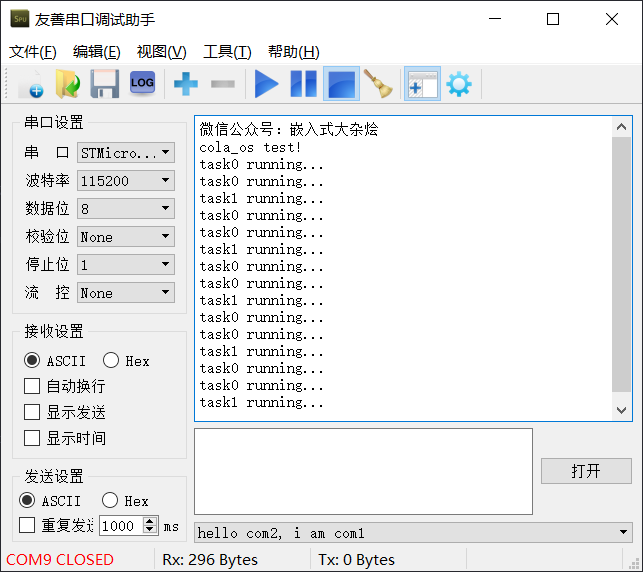大家好,我是杂烩君。
嵌入式大杂烩周记主要是一些实用项目学习分享,每周一篇,每篇一个主题。
内容主要来源于我们之前收集的资料:
https://gitee.com/zhengnianli/EmbedSummary
本期主角:cola_os
cola_os是一个300多行代码实现的多任务管理的OS,在很多MCU开发中,功能很简单,实时性要求不强,任务多了管理不当又很乱。
如果使用RTOS显得太浪费,这时候可以尝试使用使用cola_os这类基于软件定时器实现的时间片轮询框架。
仓库链接:
https://gitee.com/schuck/cola_os
license:MulanPSL-1.0(木兰宽松许可证, 第1版)。
cola_os是一份简洁明了的代码,包含很多有用的编程思想,值得通读。下面我们一起来学习一下:
cola_os的分析及使用
其实关于cola_os其实我们前几天的推文中也有做介绍。今天我们再一起来完整地梳理一遍。
cola_os目前的内容如:


1、cola_os
cola_os就是cola_os的任务管理模块。任务使用链表进行管理,其数据结构如:
1
2
3
4
5
6
7
8
9
10
11
12
13
14
15typedef void (*cbFunc)(uint32_t event); typedef struct task_s { uint8_t timerNum; //定时编号 uint32_t period; //定时周期 bool oneShot; //true只执行一次 bool start; //开始启动 uint32_t timerTick; //定时计数 bool run; //任务运行标志 bool taskFlag; //任务标志是主任务还是定时任务 uint32_t event; //驱动事件 cbFunc func; //回调函数 struct task_s *next; }task_t;
每创建一个任务吗,就是往任务链表中插入一个任务节点。
其创建任务的方法有两种:
-
创建主循环任务
-
创建定时任务
两种方式创建,都是会在while(1)循环中调度执行任务函数。
我们可以看看cola_task_loop任务遍历函数,这个函数最终是要放在主函数while(1)中调用的。其内容如:
1
2
3
4
5
6
7
8
9
10
11
12
13
14
15
16
17
18
19
20
21
22
23
24
25
26
27
28
29
30
31
32
33
34
35void cola_task_loop(void) { uint32_t events; task_t *cur = task_list; OS_CPU_SR cpu_sr; while( cur != NULL ) { if(cur->run) { if(NULL !=cur->func) { events = cur->event; if(events) { enter_critical(); cur->event = 0; exit_critical(); } cur->func(events); } if(TASK_TIMER == cur->taskFlag) { enter_critical(); cur->run = false; exit_critical(); } if((cur->oneShot)&&(TASK_TIMER == cur->taskFlag)) { cur->start = false; } } cur = cur->next; } }
两种方式创建的任务都会在cur->func(events);被调用。不同的就是:遍历执行到定时任务时,需要清掉定时相关标志。
其中,events作为任务函数的参数传入。从cola_task_loop可以看到,事件并未使用到,events无论真还是假,在执行任务函数前,都被清零了。events的功能应该是作者预留的。
创建任务很简单,比如创建一个定时任务:
1
2
3
4
5
6
7
8
9
10static task_t timer_500ms; //每500ms执行一次 static void timer_500ms_cb(uint32_t event) { printf("task0 running...n"); } cola_timer_create(&timer_500ms, timer_500ms_cb); cola_timer_start(&timer_500ms, TIMER_ALWAYS, 500);
cola_os是基于软件定时器来进行任务调度管理的,需要一个硬件定时器提供时基。比如使用系统滴答定时器,配置为1ms中断一次。
在1ms中断中不断轮询判断定时计数是否到达定时时间:
1
2
3
4
5
6
7
8
9
10
11
12
13
14
15
16
17
18
19
20
21
22
23
24
25
26
27void SysTick_Handler(void) { cola_timer_ticker(); } void cola_timer_ticker(void) { task_t *cur = task_list; OS_CPU_SR cpu_sr; while( cur != NULL ) { if((TASK_TIMER == cur->taskFlag)&& cur->start) { if(++cur->timerTick >= cur->period) { cur->timerTick = 0; if(cur->func != NULL) { enter_critical(); cur->run = true; exit_critical(); } } } cur = cur->next; } }
如果到了则将标志cur->run置位,在while大循环中的cola_task_loop函数中如果检测到该标志就执行该任务函数。
2、cola_device
cola_device是硬件抽象层,使用链表来管理各个设备。其借鉴了RT-Thread及Linux相关驱动框架思想。大致内容如:
数据结构如:
1
2
3
4
5
6
7
8
9
10
11
12
13
14
15
16
17
18
19typedef struct cola_device cola_device_t; struct cola_device_ops { int (*init) (cola_device_t *dev); int (*open) (cola_device_t *dev, int oflag); int (*close) (cola_device_t *dev); int (*read) (cola_device_t *dev, int pos, void *buffer, int size); int (*write) (cola_device_t *dev, int pos, const void *buffer, int size); int (*control)(cola_device_t *dev, int cmd, void *args); }; struct cola_device { const char * name; struct cola_device_ops *dops; struct cola_device *next; };
硬件抽象层的接口如:
1
2
3
4
5
6
7
8
9
10
11
12
13
14
15
16
17
18
19
20/* 驱动注册 */ int cola_device_register(cola_device_t *dev); /* 驱动查找 */ cola_device_t *cola_device_find(const char *name); /* 驱动读 */ int cola_device_read(cola_device_t *dev, int pos, void *buffer, int size); /* 驱动写 */ int cola_device_write(cola_device_t *dev, int pos, const void *buffer, int size); /* 驱动控制 */ int cola_device_ctrl(cola_device_t *dev, int cmd, void *arg);
首先,在驱动层注册好设备,把操作设备的函数指针及设备名称插入到设备链表中:
1
2
3
4
5
6
7
8
9
10
11
12
13
14
15
16
17
18
19
20
21
22
23
24
25
26
27
28
29
30
31
32
33
34
35
36
37
38
39
40
41static cola_device_t led_dev; static void led_gpio_init(void) { GPIO_InitTypeDef GPIO_InitStructure; RCC_AHBPeriphClockCmd(RCC_AHBPeriph_GPIOC, ENABLE); GPIO_InitStructure.GPIO_Pin = PIN_GREENLED; GPIO_InitStructure.GPIO_Mode = GPIO_Mode_OUT; GPIO_InitStructure.GPIO_Speed = GPIO_Speed_50MHz; GPIO_InitStructure.GPIO_OType = GPIO_OType_PP; GPIO_InitStructure.GPIO_PuPd = GPIO_PuPd_NOPULL; GPIO_Init(PORT_GREEN_LED, &GPIO_InitStructure); LED_GREEN_OFF; } static int led_ctrl(cola_device_t *dev, int cmd, void *args) { if(LED_TOGGLE == cmd) { LED_GREEN_TOGGLE; } else { } return 1; } static struct cola_device_ops ops = { .control = led_ctrl, }; static void led_register(void) { led_gpio_init(); led_dev.dops = &ops; led_dev.name = "led"; cola_device_register(&led_dev); }
cola_device_register函数如:
1
2
3
4
5
6
7
8
9
10
11
12
13int cola_device_register(cola_device_t *dev) { if((NULL == dev) || (cola_device_is_exists(dev))) { return 0; } if((NULL == dev->name) || (NULL == dev->dops)) { return 0; } return device_list_inster(dev); }
驱动注册好设备之后,应用层就可以根据设备名称来查找设备是否被注册,如果已经注册则可以调用设备操作接口操控设备。比如创建一个定时任务定时反转led:
1
2
3
4
5
6
7
8
9
10
11
12void app_init(void) { app_led_dev = cola_device_find("led"); assert(app_led_dev); cola_timer_create(&timer_500ms,timer_500ms_cb); cola_timer_start(&timer_500ms,TIMER_ALWAYS,500); } static void timer_500ms_cb(uint32_t event) { cola_device_ctrl(app_led_dev,LED_TOGGLE,0); }
3、cola_init
cola_init是一个自动初始化模块,模仿Linux的initcall机制。RT-Thread也有实现这个功能:

一般的,我们的初始化在主函数中调用,如:

有了自动初始化模块,可以不在主函数中调用,例如:
1
2
3
4void SystemClock_Config(void) { } pure_initcall(SystemClock_Config);
这样也可以调用SystemClock_Config。pure_initcall如:
1
2
3
4
5
6
7
8
9
10
11
12#define __used __attribute__((__used__)) typedef void (*initcall_t)(void); #define __define_initcall(fn, id) static const initcall_t __initcall_##fn##id __used __attribute__((__section__("initcall" #id "init"))) = fn; #define pure_initcall(fn) __define_initcall(fn, 0) //可用作系统时钟初始化 #define fs_initcall(fn) __define_initcall(fn, 1) //tick和调试接口初始化 #define device_initcall(fn) __define_initcall(fn, 2) //驱动初始化 #define late_initcall(fn) __define_initcall(fn, 3) //其他初始化
在cola_init中,首先是调用不同顺序级别的__define_initcall宏来把函数指针fn放入到自定义的指定的段中。各个需要自动初始化的函数放到指定的段中,形成一张初始化函数表。
__ attribute __ (( __ section __)) 关键字就是用来指定数据存放段。
do_init_call函数在我们程序起始时调用,比如在bsp_init中调用:
1
2
3
4void bsp_init(void) { do_init_call(); }
do_init_call里做的事情就是遍历初始化函数表里的函数:
1
2
3
4
5
6
7
8
9
10
11
12
13
14
15
16
17
18
19
20
21
22
23
24
25
26
27
28
29
30
31
32
33
34
35
36
37
38
39
40
41
42
43
44
45void do_init_call(void) { extern initcall_t initcall0init$$Base[]; extern initcall_t initcall0init$$Limit[]; extern initcall_t initcall1init$$Base[]; extern initcall_t initcall1init$$Limit[]; extern initcall_t initcall2init$$Base[]; extern initcall_t initcall2init$$Limit[]; extern initcall_t initcall3init$$Base[]; extern initcall_t initcall3init$$Limit[]; initcall_t *fn; for (fn = initcall0init$$Base; fn < initcall0init$$Limit; fn++) { if(fn) (*fn)(); } for (fn = initcall1init$$Base; fn < initcall1init$$Limit; fn++) { if(fn) (*fn)(); } for (fn = initcall2init$$Base; fn < initcall2init$$Limit; fn++) { if(fn) (*fn)(); } for (fn = initcall3init$$Base; fn < initcall3init$$Limit; fn++) { if(fn) (*fn)(); } }
这里有 initcall0init $$ Base 及 initcall0init Limit这几个initcall_t类型的函数指针数组的声明。它们事先是调用__define_initcall把函数指针fn放入到自定义的指定的段.initcall0init、.initcall1init、.initcall2init、.initcall3init。
initcall0init$$Base与initcall0init$$Limit按照我的理解就是各个初始化函数表的开始及结束地址。从而实现遍历:
1
2
3
4
5
6
7for (fn = initcall0init$$Base; fn < initcall0init$$Limit; fn++) { if(fn) (*fn)(); }
例如RT-Thread里的实现也是类似的:
1
2
3
4
5
6volatile const init_fn_t *fn_ptr; for (fn_ptr = &__rt_init_rti_board_start; fn_ptr < &__rt_init_rti_board_end; fn_ptr++) { (*fn_ptr)(); }
关于init自动初始化机制大致就分析这些。
cola_os包含有cola_os任务管理、cola_device硬件抽象层及cola_init自动初始化三大块,这三块内容其实可以单独抽出来学习、使用。
4、cola_os的使用
下面我们基于小熊派IOT开发板来简单实践实践。

我们创建两个定时任务:
-
task0任务:定时500ms打印一次。
-
task1任务:定时1000ms打印一次。
main.c:
1
2
3
4
5
6
7
8
9
10
11
12
13
14
15
16
17
18
19
20
21
22
23
24
25
26
27
28
29
30
31
32
33
34
35
36
37
38
39
40
41
42
43
44
45
46
47
48
49
50
51
52
53
54
55
56
57
58
59
60
61
62
63
64
65
66
67
68
69
70
71
72
73
74
75
76
77
78
79
80
81
82
83
84
85
86
87
88
89
90
91
92
93
94
95
96
97
98
99
100
101
102
103
104
105
106
107
108
109
110
111
112
113
114
115
116
117
118
119
120
121
122
123
124
125
126
127
128
129
130
131
132
133
134
135
136
137
138
139
140
141
142
143
144
145
146
147/* Private variables ---------------------------------------------------------*/ static task_t timer_500ms; static task_t timer_1000ms; /* USER CODE END PV */ /* Private function prototypes -----------------------------------------------*/ void SystemClock_Config(void); /* USER CODE BEGIN PFP */ /* Private function prototypes -----------------------------------------------*/ /* USER CODE END PFP */ /* USER CODE BEGIN 0 */ //每500ms执行一次 static void timer_500ms_cb(uint32_t event) { printf("task0 running...n"); } //每1000ms执行一次 static void timer_1000ms_cb(uint32_t event) { printf("task1 running...n"); } int main(void) { /* USER CODE BEGIN 1 */ /* USER CODE END 1 */ /* MCU Configuration----------------------------------------------------------*/ /* Reset of all peripherals, Initializes the Flash interface and the Systick. */ HAL_Init(); /* USER CODE BEGIN Init */ /* USER CODE END Init */ /* Configure the system clock */ // SystemClock_Config(); /* USER CODE BEGIN SysInit */ /* USER CODE END SysInit */ /* Initialize all configured peripherals */ MX_GPIO_Init(); MX_DMA_Init(); MX_USART1_UART_Init(); /* USER CODE BEGIN 2 */ printf("微信公众号:嵌入式大杂烩rn"); printf("cola_os test!rn"); cola_timer_create(&timer_500ms,timer_500ms_cb); cola_timer_start(&timer_500ms,TIMER_ALWAYS,500); cola_timer_create(&timer_1000ms,timer_1000ms_cb); cola_timer_start(&timer_1000ms,TIMER_ALWAYS,1000); /* USER CODE END 2 */ /* Infinite loop */ /* USER CODE BEGIN WHILE */ while (1) { /* USER CODE END WHILE */ /* USER CODE BEGIN 3 */ cola_task_loop(); } /* USER CODE END 3 */ } /** * @brief System Clock Configuration * @retval None */ void SystemClock_Config(void) { RCC_OscInitTypeDef RCC_OscInitStruct; RCC_ClkInitTypeDef RCC_ClkInitStruct; RCC_PeriphCLKInitTypeDef PeriphClkInit; /**Initializes the CPU, AHB and APB busses clocks */ RCC_OscInitStruct.OscillatorType = RCC_OSCILLATORTYPE_MSI; RCC_OscInitStruct.MSIState = RCC_MSI_ON; RCC_OscInitStruct.MSICalibrationValue = 0; RCC_OscInitStruct.MSIClockRange = RCC_MSIRANGE_6; RCC_OscInitStruct.PLL.PLLState = RCC_PLL_ON; RCC_OscInitStruct.PLL.PLLSource = RCC_PLLSOURCE_MSI; RCC_OscInitStruct.PLL.PLLM = 1; RCC_OscInitStruct.PLL.PLLN = 40; RCC_OscInitStruct.PLL.PLLP = RCC_PLLP_DIV7; RCC_OscInitStruct.PLL.PLLQ = RCC_PLLQ_DIV2; RCC_OscInitStruct.PLL.PLLR = RCC_PLLR_DIV2; if (HAL_RCC_OscConfig(&RCC_OscInitStruct) != HAL_OK) { _Error_Handler(__FILE__, __LINE__); } /**Initializes the CPU, AHB and APB busses clocks */ RCC_ClkInitStruct.ClockType = RCC_CLOCKTYPE_HCLK|RCC_CLOCKTYPE_SYSCLK |RCC_CLOCKTYPE_PCLK1|RCC_CLOCKTYPE_PCLK2; RCC_ClkInitStruct.SYSCLKSource = RCC_SYSCLKSOURCE_PLLCLK; RCC_ClkInitStruct.AHBCLKDivider = RCC_SYSCLK_DIV1; RCC_ClkInitStruct.APB1CLKDivider = RCC_HCLK_DIV1; RCC_ClkInitStruct.APB2CLKDivider = RCC_HCLK_DIV1; if (HAL_RCC_ClockConfig(&RCC_ClkInitStruct, FLASH_LATENCY_4) != HAL_OK) { _Error_Handler(__FILE__, __LINE__); } PeriphClkInit.PeriphClockSelection = RCC_PERIPHCLK_USART1; PeriphClkInit.Usart1ClockSelection = RCC_USART1CLKSOURCE_PCLK2; if (HAL_RCCEx_PeriphCLKConfig(&PeriphClkInit) != HAL_OK) { _Error_Handler(__FILE__, __LINE__); } /**Configure the main internal regulator output voltage */ if (HAL_PWREx_ControlVoltageScaling(PWR_REGULATOR_VOLTAGE_SCALE1) != HAL_OK) { _Error_Handler(__FILE__, __LINE__); } /**Configure the Systick interrupt time */ HAL_SYSTICK_Config(HAL_RCC_GetHCLKFreq()/1000); /**Configure the Systick */ HAL_SYSTICK_CLKSourceConfig(SYSTICK_CLKSOURCE_HCLK); /* SysTick_IRQn interrupt configuration */ HAL_NVIC_SetPriority(SysTick_IRQn, 0, 0); } pure_initcall(SystemClock_Config);
SysTick_Handler:
1
2
3
4
5
6
7
8
9
10
11
12void SysTick_Handler(void) { /* USER CODE BEGIN SysTick_IRQn 0 */ /* USER CODE END SysTick_IRQn 0 */ cola_timer_ticker(); HAL_IncTick(); HAL_SYSTICK_IRQHandler(); /* USER CODE BEGIN SysTick_IRQn 1 */ /* USER CODE END SysTick_IRQn 1 */ }
编译、下载、运行:

从运行结果可以看到,task1的定时周期是task0的两倍,符合预期。
本文代码工程可在本公众号后台回复关键词:cola_os测试 ,即可获取。
以上就是本次的分享,文章如有错误,欢迎指出,谢谢!
咱们下期见~
最后
以上就是俊逸紫菜最近收集整理的关于嵌入式大杂烩周记 | 第 4 期:cola_os的全部内容,更多相关嵌入式大杂烩周记内容请搜索靠谱客的其他文章。








发表评论 取消回复